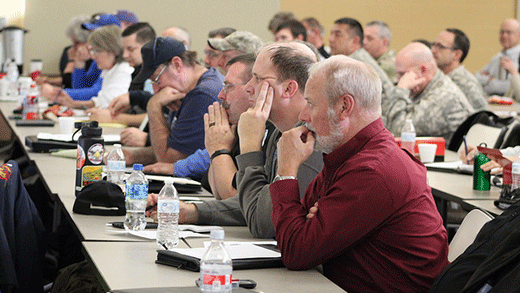
Attendees listened to an afternoon speaker at the 2019 Wildfire Outlook Seminar in Wichita on Dec. 12, hosted by Kansas Forest Service, Kansas Division of Emergency Management and the Office of the State Fire Marshall. | Download this photo.
Wildfire season in Kansas projected to start earlier; slight increase in fire weather events predicted
State agencies, firefighters and emergency managers prepare communities for the 2019 wildfire season
December 19, 2018
WICHITA, Kan. -- Southwest and central Kansas face an elevated threat of wildfire in the 2019 season, according to projections by the Kansas Mesonet and National Weather Service. The news came as Kansas Forest Service, Kansas Division of Emergency Management and the Office of the State Fire Marshall officials gathered in Wichita for the Kansas 2019 Wildfire Outlook Seminar on Dec. 12. The seminar was designed to update firefighters and emergency managers on the predicted wildfire season.
Understanding weather conditions and climate trends is a key aspect of fighting and preparing for wildfires in Kansas.
“We are seeing increased fuel loads in this region because of the late summer rains we received,” said Chip Redmond, mesonet manager and assistant scientist in the Weather Data Library at Kansas State University.
Redmond said that despite above-normal moisture across most of the state this winter, a slightly earlier start to the spring fire season is expected accompanied by an earlier-than-usual spring green up that could add fuel if freeze damage occurs. The combination of factors has heightened fire concerns for any fire weather event in the southwest and central part of the state.
The seminar is one way Kansas fire agencies prepare for potential wildfires.
In addition to the climatology and weather outlook, speakers reviewed reporting requirements, discussed the building of intrastate and interstate capacity, requesting state resources, aerial firefighting suppression and other topics relevant to local and rural fire departments.
While there was a decrease in acres burned and total number of fires in 2018, the fires of 2016 and 2017 burned over 800,000 acres with a cost of more than $80 million. Aggressive initial attack, improved coordination and access to mutual aid kept the impact of wildfires in 2018 to a minimum.
By the end of March 2018, KFS had already conducted more training with fire departments across Kansas than in any other year.
“Local fire authorities are building their capacity and coordination to fight wildfires in the state through the training we offer,” said Eric Ward, assistant fire management officer for KFS. “Their initial response and pre-coordination of resources is essential in minimizing the impact of wildfires in Kansas. We are proud to partner with KDEM and OSFM to support their efforts.”

